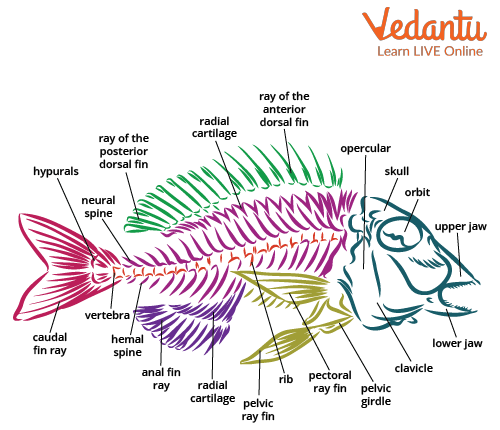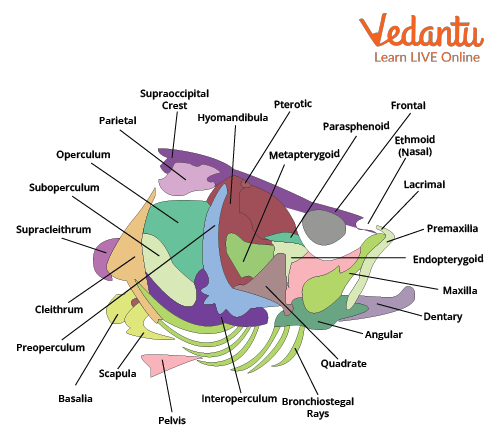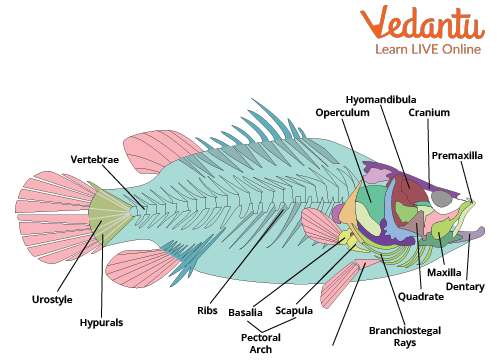Fish Skeletal System: An Introduction
The structure of bones and cartilage that supports the body is known as the fish skeletal system. A fish is an aquatic and vertebrate animal. It has a well-developed skeleton system that helps in the formation of body structure. Even more basic is the skeleton of the Hagfish. Although the skeletons of sharks and rays are more complicated, they are still mostly made of cartilage rather than bones.
What is Skeleton?
A particular organism's skeleton is a typically stiff supporting or protecting structure or framework. The internal organs of a vertebrate are supported by and protected by a bony or mostly cartilaginous framework.
Fish Skeleton
Fish have vertebrae. The vertebrae, which make up the spine, have bone or cartilage that surrounds the dorsal nerve cord. A fish skeleton is formed of bones and cartilage. Some fish which are formed of only bones are called bony fishes, while those formed of cartilage are called cartilaginous fishes.
The predatory fishes in the class Chondrichthyes include sharks, rays, skates, and ratfishes. They have jaws and paired fins. Many of them have their skin covered by a special form of scale, and their skeleton is composed of cartilage rather than bone. These are cartilaginous fish.
Structure of Fish Skeleton

Skeleton of Fish
Fish Bones
Bones may recover on their own and become stronger than the original bone since they are made of tissues that include blood vessels and nerves. The skeleton system of a fish has many small bones. Approximately 150 bones are present in the skeletal system. The bones are dense, less flexible connective tissue.
Vomer: On the roof of the mouth is the vomer midline bone, which typically supports teeth.
Maxillary: Paired bones are located behind or above these bones (toothed primitively).
Articular: A moveable joint is formed dorsally by a pair of paired, angular-shaped bones that are articulated and take up a portion of the lower jaw's posterior end.
Retro Articular: Paired bones are located at each articular's lower posterior corner.
Dentary: Large paired dental bones that are united medially and create the lower jaw's front (toothed).
Opercle: Flat, paired, and connected to hyomandibula bones form the majority of the gill cover.
Centrum: The centrum, the central, cylindrical component of each vertebra, obstructs the embryonic notochord during ossification.
Scapula: They are a pair of flat bones that articulate with the cleithra posteriorly and the coracoids anteriorly. The cleithra and scapula articulate with the coracoid paired bones. Small bones, called radials, connect the fin rays; they articulate anteriorly with the scapula and coracoid bones.
Fish Skull
The skull is also known as the cranium. The fish's skull is really a double construction made up of two bone "boxes" that are encased in one another.
Dermal bone forms the outer shell of the skull. Endochondral bone makes up the inside of the skull. On the surface of the gills, there is an operculum. First, on top of the gills, is the preoperculum. The premaxilla is very close to the mouth. Second, in the mouth, after the palatine are the maxillae. The jaw's bottom is called the dental, and between the palatine and the dentary lies the angular. Between the palatine and hyomandibular is the quadrate, while the hyomandibular and cranium are joined. The mouth roof refers to the palatine.

Skull Anatomy of Fish
Function of Skull
Fishes have a cranium (skull), which protects the brain. The skull covers the brain and protects it from any injury and shock.
Vertebral Column
The vertebral column is made up of a number of endochondral bones known as vertebrae. The centrum of one is the enormous spool-shaped core region. The trunk and the tail are the two sections of the fish’s vertebral column. Fish ribs are attached to the spinal column in the trunk region.
Pectoral and Pelvic Girdle
The pectoral fin is connected to the fish skeleton by the pectoral gridle. The pelvic girdle joins the fish skeleton to the pelvic fin. The pelvic girdle is free-floating and not connected to the spinal column or the pectoral girdle.
Types of Skeleton
There are two basic kinds of skeletons:
The exoskeleton, which serves as an organism's sturdy exterior shell, and
The endoskeleton, which provides the body's internal support system. The exoskeleton has scales of fishes.
An animal's internal support system, or endoskeleton, is made of tissue that has undergone mineralisation. The skin or deeper bodily tissues are where the endoskeleton develops. Essentially, a vertebrate has an endoskeleton consisting of two different types of tissues (bone and cartilage). Exoskeletons are skeletons that are external to the animal and are created to protect certain bodily parts.
Parts of the Skeleton
A fish is a vertebrate, and vertebrate skeletons may be generally classified into two axial and appendicular skeletons. The skull, vertebrae, and ribs make up the axial skeleton.
The pectoral and pelvic girdles, as well as the bones of the appendages, make up the appendicular skeleton.

Fish Skeleton System
Function of Skeleton
It provides a framework and support that surrounds and supports the body's soft organs. The heart, lungs, and brain are among the fragile organs that the skeleton protects. It aids in bodily movement, and muscles use bones as levers. The bone is a component of the skeleton and aids in the storage of minerals like calcium and phosphate. Bone marrow in the bones aids in the production of blood cells.
Conclusion
Fishes are vertebrates and have bones and cartilage in their skeletal system. This skeletal system helps to make the framework of fishes. The fishes can be bony fishes in which only bones are present or can be cartilage fishes in which only cartilages are functional to form a skeleton.


FAQs on Fish Skeletal System
1. What are the differences between bony and cartilaginous fishes?
Bones make up the whole endoskeleton of bony fish. They feature a mouth hole on the front tip. Fish that live in fresh or salt water can both exist. On either side of their gills, they have an operculum. They have a bladder for air. They have a homocercal tail fin. They externally fertilise their eggs. Bony fish include eels, sea horses, flying fish, and globe fish. There are no freshwater fish among the cartilaginous fishes. The majority of their endoskeleton is composed of cartilage. They use internal systems for fertilisation.
This category of fish includes dogfish, skates, electric ray torpedoes, and sharks.
2. How are fish classified?
Fishes are divided into three categories: bony fish, cartilaginous fish, and fish without jaws. Class Agnatha, which dates back to the Cambrian period, includes jawless fish. These are the planet's earliest vertebrates. Fish without jaws include lampreys and hagfish. Lamprey adhere to fish, whales, and dolphins and ingest their host's tissues and bodily fluids.
Chondrichthyes are the class of cartilaginous fish. All that these fish have is cartilage. Examples include rays, skates, and sharks. The majority of fish that belong to the class Osteichthyes are bony fish. Due to a thin layer of skin covering tiny bones and girdles, the majority of fish have ray fins.
3. Why do fish bones have sharp points?
Fishes live in water, and every living thing on the planet seeks a self-defence mechanism by which it may shield itself from predators. Fish are eaten by large marine organisms in the ocean, as well as by humans. Fish have sharp spikes on their bones to defend themselves from other predators. These pointed bones are difficult and dangerous to consume, and they can hurt the prey. So, predators try to stay away from such food. However, humans still consume fish by applying several strategies to remove the fish's body's pointed, sharp bones.










